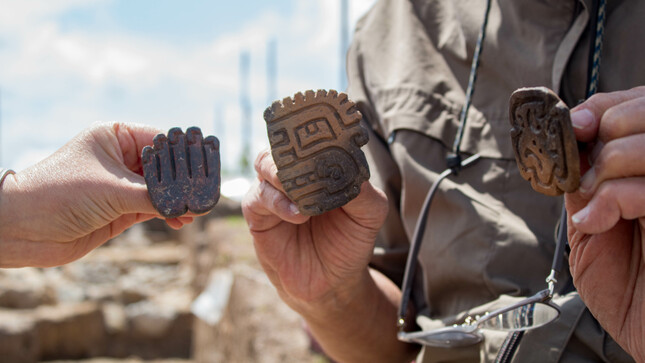A team of archaeologists has made an important discovery in the province of Chota in Cajamarca, Peru. They have unearthed the tomb of a shaman who is thought to have lived around 3,000 years ago. The find represents the first priestly figure of its kind in the region.
The individual, who was buried with a depiction of a “jaguar”, was found at the Pacopampa Archaeological Complex, which is located in the country’s northern highlands. This site has been the source of various ancient burials that collaborative teams from Peru and Japan have been exploring since 2005, Peru’s Ministry of Culture explained in a statement.
The priest’s tomb comprised a large three-meter wide circular pit that was about one meter deep and was made during the Pacopampa I phase (around 1,000 BCE). The body, which belonged to an adult, was placed with arms and legs crossed and was buried face down.
“In 43 years of research in Peru, it is the first time I have seen that position,” Yuji Seki, an archaeologist with Japan’s National Museum of Ethnology and co-director of the archaeological team, explained to El País.
Strangely, the priest was also buried below six layers of black earth mixed with ash and his body was surrounded by various funerary offerings, including ceramic bowls and intricately designed seals. These seals, one of which had a jaguar engraved on it, may have been used for ritualistic body painting for elite individuals.

The shaman was recovered alongside several objects, including special seals that may have been used in ritual ceremonies. Image credit: Peru Ministry of Culture.
In addition to these rich objects, the priest’s face was also covered with red cinnabar, a naturally occurring ore that would have been brought to the site from the mountains. “Cinnabar is believed to have originated in the central Andean highlands, and we believe that only the elite could have obtained or used it by large distance trade,” Seki told Live Science.
According to Seki, although the individual is referred to as a priest, it would be more accurate to regard him as a “shaman-like figure who manipulated the powers of jaguars, snakes, and birds of prey”. As with other spiritual figures of this kind, it is likely that people turned to him for advice and healing.
The discovery demonstrates how significant the Pacopampa Archaeological Project is. According to the researchers, the site was a pilgrimage center that Peruvians traveled to for sacred purposes. There are now plans to open a formal research center – the Pacopampa Interpretation Center – at the site which will allow the researchers to further their analysis, but also provide tourists with something to visit.
Source Link: Archaeologists Discover 3,000-Year-Old Shaman’s Tomb In Peru